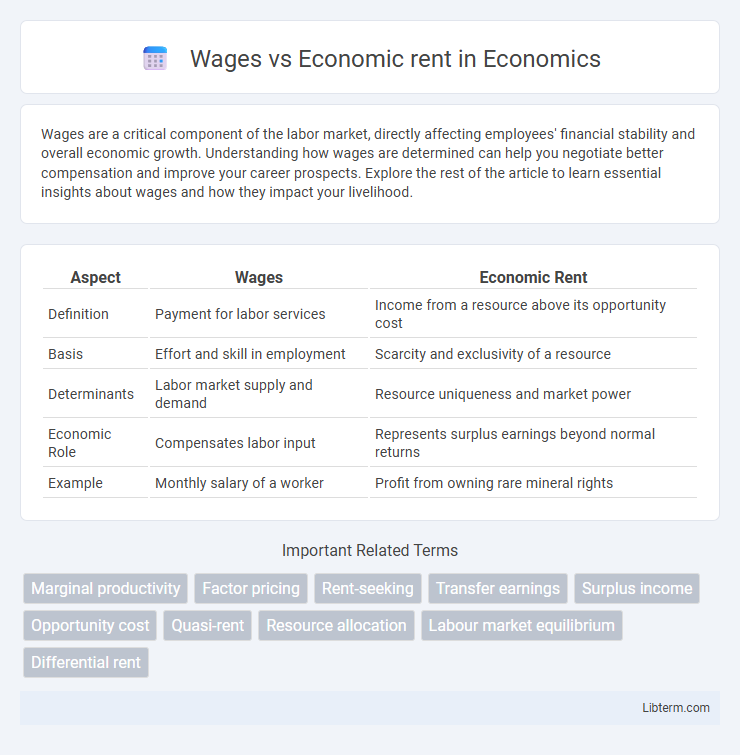Wages are a critical component of the labor market, directly affecting employees' financial stability and overall economic growth. Understanding how wages are determined can help you negotiate better compensation and improve your career prospects. Explore the rest of the article to learn essential insights about wages and how they impact your livelihood.
Table of Comparison
| Aspect | Wages | Economic Rent |
|---|---|---|
| Definition | Payment for labor services | Income from a resource above its opportunity cost |
| Basis | Effort and skill in employment | Scarcity and exclusivity of a resource |
| Determinants | Labor market supply and demand | Resource uniqueness and market power |
| Economic Role | Compensates labor input | Represents surplus earnings beyond normal returns |
| Example | Monthly salary of a worker | Profit from owning rare mineral rights |
Defining Wages and Economic Rent
Wages represent the monetary compensation paid to labor for their productive services, reflecting the equilibrium between labor supply and demand in competitive markets. Economic rent refers to the surplus payment to a factor of production that exceeds the minimum amount necessary to keep it employed, often arising from unique resource scarcity or monopoly power. Distinguishing wages from economic rent involves understanding that wages are opportunity costs for labor, while economic rent captures unearned income beyond normal competitive returns.
Historical Context of Wages and Economic Rent
Wages historically represent payments to labor for productive work, evolving through industrial revolutions where market demand and worker skills shaped income levels. Economic rent emerges from ownership or control over scarce resources, with classical economists like David Ricardo emphasizing land rent as surplus income beyond production costs. The tension between wages and economic rent reflects shifts in economic structures, influencing wealth distribution and labor-capital relations over time.
Key Differences Between Wages and Economic Rent
Wages represent compensation paid to labor for services rendered, reflecting the opportunity cost and productivity of the worker. Economic rent, in contrast, is the payment to a factor of production exceeding its opportunity cost, often arising from scarcity or unique advantages. Key differences include wages being determined by supply and demand in competitive labor markets, while economic rent results from monopolistic conditions or fixed supply.
Determinants of Wage Levels
Wage levels are primarily determined by factors such as education, skills, experience, and productivity of the workforce, which influence the supply and demand for labor in different industries. Economic rent arises when workers receive compensation above their opportunity cost due to scarcity or monopolistic advantages in the labor market. Market conditions, institutional factors like minimum wage laws, and bargaining power also play critical roles in shaping wage disparities beyond basic economic rent.
Factors Influencing Economic Rent
Economic rent is influenced by resource scarcity, unique location advantages, and inherent productivity differences, creating payments above the minimum required to employ the factor. Wages reflect compensation for labor based on supply and demand, while economic rent arises from limited alternatives or exclusivity. Factors such as land fertility, natural resource endowments, and legal restrictions significantly determine the magnitude of economic rent.
The Role of Labor Markets in Wage Formation
Labor markets play a crucial role in wage formation by balancing the supply of labor with employer demand, determining the equilibrium wage rate that compensates workers for their opportunity costs rather than economic rent, which represents income above the worker's reservation wage. Wages reflect the marginal productivity of labor, influenced by factors such as skill levels, union negotiations, and labor market competition, whereas economic rent emerges from scarcity or market power, often accruing to workers with unique or highly sought-after skills. Understanding the distinction between wages and economic rent is essential for analyzing income distribution and labor market efficiency in economic theory.
Economic Rent in Land, Labor, and Capital
Economic rent refers to the surplus payment made to a factor of production--land, labor, or capital--that exceeds the minimum amount necessary to keep it in its current use. In land, economic rent arises because of its fixed supply and location advantages, leading to payments beyond production costs. For labor, economic rent is seen in unique skills or monopolistic labor market conditions, while in capital, it occurs when returns exceed opportunity costs due to monopolies or limited competition.
Impacts on Income Distribution
Wages represent payments to labor based on productivity and skills, directly influencing the income distribution by compensating workers according to their contribution to production. Economic rent, derived from ownership of scarce resources or monopolistic advantages, tends to concentrate wealth by generating unearned income, exacerbating income inequality. The disparity between wages and economic rent often leads to a skewed income distribution, where returns to capital and landowners outpace those of labor, reinforcing economic stratification.
Policy Implications: Addressing Wage and Rent Disparities
Policies targeting wage and economic rent disparities must balance labor market regulations with measures controlling rent-seeking behaviors to promote equitable income distribution. Implementing progressive taxation on economic rents, along with raising minimum wages and strengthening collective bargaining, mitigates income inequality and enhances social mobility. Accurate measurement of economic rent and wage differentials informs targeted interventions that reduce market distortions and economic inefficiencies.
Future Trends in Wages and Economic Rent
Future trends in wages are influenced by automation, artificial intelligence, and globalization, which may suppress wage growth for routine tasks while increasing demand and pay for specialized skills. Economic rent, defined as earnings exceeding the minimum required to keep a factor employed, is expected to rise in industries with scarce resources or unique intellectual property rights, such as tech and real estate. The growing disparity between wage growth and economic rent highlights structural shifts in labor markets and capital ownership patterns.
Wages Infographic

 libterm.com
libterm.com